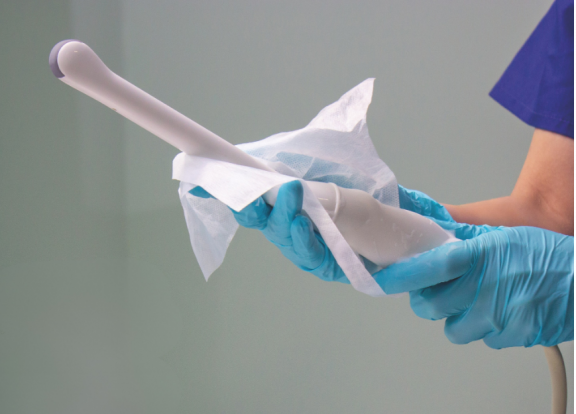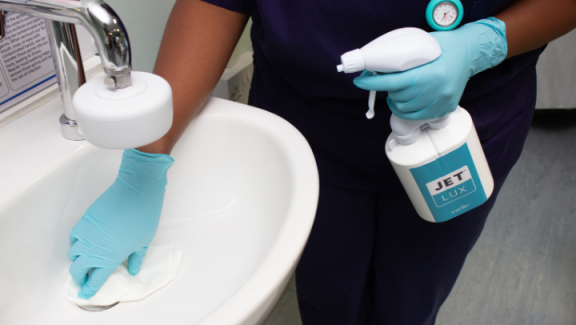Globally, more than one million sexually transmitted infections occur each day1
Endocavity ultrasound probes are used to examine the female reproductive organs, the rectum, and nearby structures. Due to where endocavity ultrasound probes are used, they risk transmitting pathogens that are associated with sexually transmitted infections (STIs) to patients and healthcare workers.
Human Papillomavirus (HPV)
• Globally, more than 300 million women have an HPV infection1.
• There are over 200 strains of HPV², of which 14 strains are considered high-risk as they are linked to causing 99% of cervical cancer cases³.
• HPV infections cause an estimated 570,000 cases of cervical cancer yearly1.
Herpes Simplex Virus (HSV)
• Can be caused by two viruses, herpes simplex virus type 1 and type 24.
• An estimated 500 million people have an HSV genital infection worldwide1.
• There are often no symptoms associated with HSV, or very mild symptoms that are frequently dismissed as other skin conditions4.
Chlamydia (Chlamydia trachomatis)
• Can cause serious, permanent damage to women’s reproductive system, leading to the inability to become pregnant5.
• An estimated 127 million new cases of Chlamydia occur yearly1.
• The foetus can be infected with Chlamydia during childbirth5.
• Is able to survive on surfaces for up to 30 hours6.
Gardnerella vaginalis and Bacterial vaginosis (BV)
• G. vaginalis can be common in the vaginal flora and is one of the causative agents of BV, a vaginal infection that can affect up to 70% of women of reproductive age7.
• G. vaginalis symptoms are usually asymptomatic unless BV occurs, where the most common symptom includes vaginal discharge with a “fishy” odour7.
• Factors that may influence the development of BV include: frequent baths, douching, multiple sex partners and increased frequency of sexual intercourse7.
Mycoplasma genitalium
• Infection can lead to complications such as urethra and cervix inflammation, endometritis, fallopian tube inflammation, tubal infertility and pre-term birth8.
• Testing for M. genitalium infection can be difficult and time consuming, due to its slow growing nature9. Isolation and culture is impractical when immediate treatment is needed9.
• Infections are often asymptomatic. Symptomatic women can present with pelvic inflammatory disease (PID)8 which is also a symptom of Chlamydia and Gonorrhoea infections, therefore misdiagnosis can occur.
Gonorrhoea (Neisseria gonorrhoeae)
• An estimated 87 million new cases of Gonorrhoea occur yearly1.
• Is able to survive on surfaces for up to three days6.
• Treatment failure with the last resort antibiotic against Gonorrhoea has occurred in at least 10 countries10.
Trichomonas vagInalis
• This protozoan parasite causes Trichomoniasis which increases the risk of getting and spreading other STIs11.
• About 70% of people infected do not have any signs or symptoms11.
• An estimated 156 million new cases of Trichomoniasis occur yearly1.
Syphilis (Treponema pallidum)
• Also called “The Great Pretender” as the symptoms are similar to other diseases12, often leading to misdiagnosis.
• An estimated 6.3 million new cases of Syphilis occur yearly1.
• There are 473 cases of congenital Syphilis to every 100,000 live births13.
TRISTEL TRIO & DUO ARE THE ONLY DISINFECTANTS PROVEN EFFECTIVE AGAINST HPV TYPES 16 & 18 IN 30 SECONDS
Meyers, C., Milici, J., Robison, R. (2020) ‘The Ability of Two Chlorine Dioxide Chemistries to Inactivate Human Papillomavirus-contaminated Endocavitary Ultrasound Probes and Nasendoscopes’. Published un the Journal Medical Virology. Read the full article here. A new scientific study by Meyers, et al. (2020) demonstrates that the Tristel Trio Wipes System and Tristel Duo ULT possess efficacy against infectious HPV types 16 and 18 on an endocavity ultrasound probe in 30 seconds.
Due to the risk of STI transmission, semi-critical devices such as endocavity ultrasound probes require high-level disinfection. The high-level disinfectant must be effective against a wide range of microorganisms including bacterial spores, mycobacteria, viruses, fungi, and vegetative bacteria. It must be compliant with regulatory standards and the latest revisions published.
For references see PDF download. ©2021 Tristel Solution Limited. All rights reserved.



